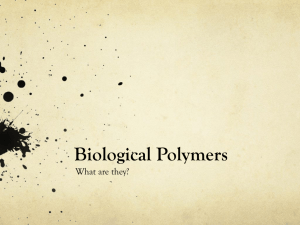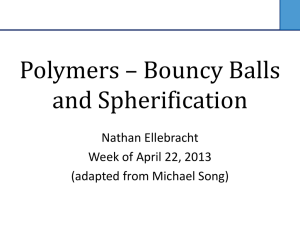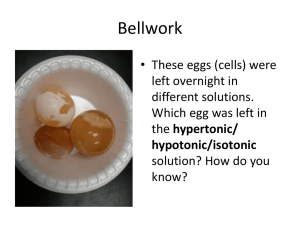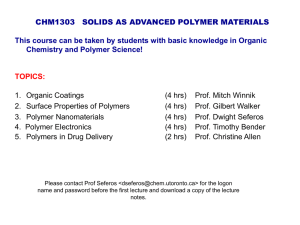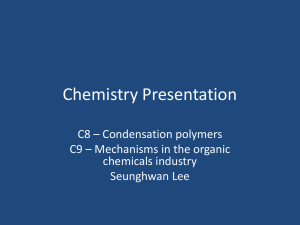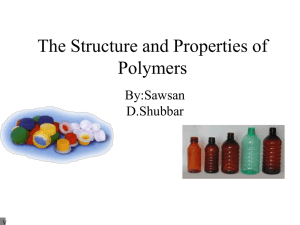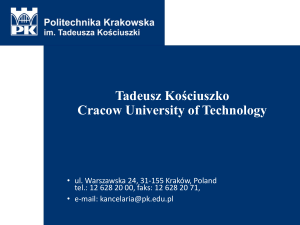Presentation
advertisement
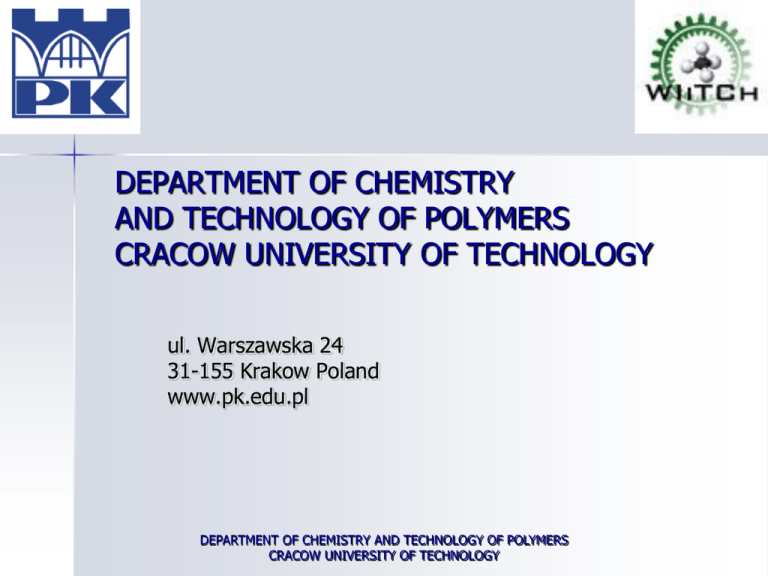
DEPARTMENT OF CHEMISTRY AND TECHNOLOGY OF POLYMERS CRACOW UNIVERSITY OF TECHNOLOGY ul. Warszawska 24 31-155 Krakow Poland www.pk.edu.pl DEPARTMENT OF CHEMISTRY AND TECHNOLOGY OF POLYMERS CRACOW UNIVERSITY OF TECHNOLOGY Profile : Department of Chemistry and Technology of Polymers (hereafter called “Department”) is a part of Faculty of Chemical Engineering and Technology at the Cracow University of Technology. In the Department there are 3 full professors, 1 associate professor, 9 adjuncts and 4 members of staff. Faculty members of the Department are involved in teaching and research in the area of polymer chemistry and technology, including materials science issues. At the post-graduate level 45 students are trained within the specialisation “technology of polymers”, performing at the final semester M.Sc. works under supervision of faculty members at the Department. Most of the research works is performed together with 12 Ph.D. students who are working towards their doctorates at the Department, being funded by Ministry of National Education and Science in Poland. DEPARTMENT OF CHEMISTRY AND TECHNOLOGY OF POLYMERS CRACOW UNIVERSITY OF TECHNOLOGY Activities : Education: the main teaching profile is technology and engineering of polymeric materials (polymers, copolymers, blends, (nano)composites, plastics, hybrid materials, etc.) and their application as innovative products in modern materials engineering. Research: synthesis, processing, characterisation and optimization of properties of polymeric materials for advanced applications. Design of structure / properties relationships in polymer nanocomposites to fabricate value-added products and technologies. Cooperation: established links with Polish polymer industry to develop jointly new products and technologies as well as to offer training possibilities and research expertize. DEPARTMENT OF CHEMISTRY AND TECHNOLOGY OF POLYMERS CRACOW UNIVERSITY OF TECHNOLOGY Expertise on following materials: • • • • • polymers copolymers blends (nano)composites hybrid materials DEPARTMENT OF CHEMISTRY AND TECHNOLOGY OF POLYMERS CRACOW UNIVERSITY OF TECHNOLOGY Actual research domains concerning materials technology /Competences : Activities : Research works performed at the Department focus on the following areas: • • • • • • Synthesis of novel polymers for special applications (e.g. biodegradable polymers, polymers from renewable resources, polymer nanohydrogels), Preparation of polymer blends and nanomaterials for thermal energy storage materials, Polymer nanocomposites with enhanced thermal properties, Recycling of polymers and plastics, particularly PVC wastes, Flame retardancy of polymeric (nano)materials, Application of novel techniques in polymer synthesis and characterisation, e.g. MT-DSC, microwaves, thermovision. DEPARTMENT OF CHEMISTRY AND TECHNOLOGY OF POLYMERS CRACOW UNIVERSITY OF TECHNOLOGY POM/MMT DEPARTMENT OF CHEMISTRY AND TECHNOLOGY OF POLYMERS CRACOW UNIVERSITY OF TECHNOLOGY Polyoxymethylene (POM) - engineering thermoplastic polymer Properties: high mechanical strength, chemical resistance, thermal resistance, good electrical properties. POM share in the worldwide production of engineering thermoplastics Other Applications: gears, conveyors, elements of pumps, belt fasteners, etc. PA POM PC DEPARTMENT OF CHEMISTRY AND TECHNOLOGY OF POLYMERS CRACOW UNIVERSITY OF TECHNOLOGY Polymer/layered silicate nanocomposites Advantages over classic composites Improved material performance at low filler loading (below 10 wt%, usually 3 -5 wt%) due to small interparticle distances and the conversion of a large fraction of the polymer matrix near their surfaces into an interphase of different properties as well as to the consequent change in morphology. Enhancement of a variety of properties, e.g. mechanical strength, thermal stability, chemical resistance, barrier properties. Elimination or reduction of processing problems, such as substantial changes in rheological properties, deterioration of surface appearance. DEPARTMENT OF CHEMISTRY AND TECHNOLOGY OF POLYMERS CRACOW UNIVERSITY OF TECHNOLOGY Structures of ammonium compounds used for MMT modification CH3 CH3 R N CH3 Cl R1 N Cl R2 2R2M 1R3M CH3 H2C CH3 CH2OH CH2 CH2 OH R N H2C CH3 Cl OH CH2 N CH2 CH2 OH RM2Et CH2OH R CH3 R N CH3 CH3 Cl RA3M, where R contains amide group DEPARTMENT OF CHEMISTRY AND TECHNOLOGY OF POLYMERS CRACOW UNIVERSITY OF TECHNOLOGY Cl RB2Et Structure of organo-modified MMT (o-MMT) XRD diffractograms of sodium MMT and o-MMT modified with different amounts of ammonium modifier (50 and 100% of cation exchange capacity of MMT). Intensity More effective in dispersing the polymer matrix were o-MMT with higher interlayer distances since organic compound facilitates exfoliation by (i) changing the hydrophilic 5,0 5,8 character of montmorillonite into Na+MMT 6,55 organophilic one thus allowing MMT-RA3M, 50% CEC macromolecules to intercalate into MMT-RA3M, 100% CEC MMT galleries, and, (ii) increasing the distance between montmorillonite layers and simultaneously weakening electrostatic forces responsible for 2 7 12 17 2 theta, degree MMT stack cohesion. DEPARTMENT OF CHEMISTRY AND TECHNOLOGY OF POLYMERS CRACOW UNIVERSITY OF TECHNOLOGY Melt blending of MMT into POM matrix Previous research on thermoplastic polymers indicated that the degree of exfoliation/intercalation of MMT is favoured by Longer time of mixing Higher speed of rotors Higher melt viscosity (higher molecular weight of polymer) Since POM is susceptible to thermomechanical degradation the optimization of processing parameters is required. DEPARTMENT OF CHEMISTRY AND TECHNOLOGY OF POLYMERS CRACOW UNIVERSITY OF TECHNOLOGY Nanocomposite structure characterization 5.2 b intensity, a.u. 6.35 a 5.5 c 2 4 6 8 10 2θ, degrees 12 14 2θ peak at ca. 5.5º indicates the presence of unintercalated stacks of organomodified MMT layers. However, taking into account the weak intensity of these peaks, partial exfoliation of montmorillonite can be considered. WAXD diffractograms of: a- pristine MMT, b - organo-modified MMT (MMT-2M2R), c - POM/MMT-2M2R nanocomposite. DEPARTMENT OF CHEMISTRY AND TECHNOLOGY OF POLYMERS CRACOW UNIVERSITY OF TECHNOLOGY Model of structure of POM/MMT nanocomposite DEPARTMENT OF CHEMISTRY AND TECHNOLOGY OF POLYMERS CRACOW UNIVERSITY OF TECHNOLOGY Structure of nanocmposites SEM microphotographs – homogenic distribution of MMT stacks and layers POM POM/Na+MMT POM/MMT-2R2M. DEPARTMENT OF CHEMISTRY AND TECHNOLOGY OF POLYMERS CRACOW UNIVERSITY OF TECHNOLOGY Core-shell structure of nanocomposite injection moulding SEM microphotographs of criofractured injection moulding sample 247 μm DEPARTMENT OF CHEMISTRY AND TECHNOLOGY OF POLYMERS CRACOW UNIVERSITY OF TECHNOLOGY Influence of MMT on crystallization process of POM Sample Enthalpy of melting Hm [J/g] Crystallinity degree C% [%] Core region Shell region Core region Shell region POM 135.1 133.7 41.4 41.0 POM/Na+MMT (microcomposite) 145.4 136.8 44.6 41.9 POM/MMT-2R2M (nanocomposite) 168.0 137.6 51.5 42.2 DEPARTMENT OF CHEMISTRY AND TECHNOLOGY OF POLYMERS CRACOW UNIVERSITY OF TECHNOLOGY POSS – polyhedral oligomeric silsesquioxanes DEPARTMENT OF CHEMISTRY AND TECHNOLOGY OF POLYMERS CRACOW UNIVERSITY OF TECHNOLOGY POSS – polyhedral oligomeric silsesquioxanes Within the latter class of materials increasing interest lies in the usage of functional polyhedral oligomeric silsesquioxanes (POSS) with a general formula (RSiO1.5)n having natural silica-type nanoparticles with a well defined structure and topology as an inorganic phase. Cubic structural compounds (completely and incompletely condensed silsesquioxanes) are commonly illustrated as T6, T8, T10 and T12, based on the number of silicon atoms present in cubic structure. POSS nanostructured chemicals, with sizes of from 1 to 3 nm in diameter, can be thought of as the smallest possible particles of silica Structures of POSS occurring most often: a – T6, b – T8, c – T10, d i e – T12. Cubane cage of POSS (RSiO1,5)8 DEPARTMENT OF CHEMISTRY AND TECHNOLOGY OF POLYMERS CRACOW UNIVERSITY OF TECHNOLOGY Polyhedral oligomeric silsesquioxanes Characteristic and properties of POSS R Thermally and chemically robust hybrid framework. Precise three-dimensional structure for molecular level reinforcement of polymer segments and coils. 1 - 3 nm (~0,5 nm) Si O R Si O O O Si O Si R O O X Si O Si R O O O R Si R Si O R One or more reactive groups for grafting or polymerization Unreactive organic (R) groups for solubilization and compatibilization POSS Properties: They occur in the form of crystalline solids, waxes and oils. Soluble in organic solvents such as THF, toluene, chloroform and hexane. They have relatively low melting point. Due to the presence of Si-O bonds are rigid and resistant to nucleophilic and electrophilic agents. DEPARTMENT OF CHEMISTRY AND TECHNOLOGY OF POLYMERS CRACOW UNIVERSITY OF TECHNOLOGY Polymeric nanohybrid materials Definitions Hybrid materials – mixtures of two or more materials with new properties created by new electron orbitals formed between each material, such as covalent bond between polymer and silanol molecules in inorganic/organic hybrids. Hybrid composite Hybrid polymer The composite material in which two or more highperformance reinforcements are combined. Understood as the polymer where an organic part is combined, on the molecular level, with an inorganic part. DEPARTMENT OF CHEMISTRY AND TECHNOLOGY OF POLYMERS CRACOW UNIVERSITY OF TECHNOLOGY Nanohybrid materials POSS/Polymer Hybrid organic-inorganic materials based on incorporating of polyoctahedral oligomeric silsesquioxanes (POSS) into polymeric matrices have received a considerable attention. A variety of POSS nanostructured chemicals contain one or more covalently bonded reactive functionalities that are suitable for polymerization, grafting, surface bonding, or other transformations. Covalently bonded POSS nanocomposites exhibit: improved thermal and mechanical stability, improved elasticity, increased the resistance to oxidation, increased the resistance to UV radiation, reinforcement of the surface, increased glass-transition temperature value, reduced flammability, enhanced mechanical strength, System of POSS-polymer. DEPARTMENT OF CHEMISTRY AND TECHNOLOGY OF POLYMERS CRACOW UNIVERSITY OF TECHNOLOGY Synthesis of PU - POSS I STEP: Synthesis of PU prepolymer: • • • • • 4,4 -methylenebis(phenylisocyanate) (MDI) poly(tetramethylene glycol) (Terathane 1400) (PTMG) 1,2-propanediol-heptaisobutyl-POSS (PHIPOSS) Temperature: 80°C Atmosphere: N2 II STEP: Synthesis of PU elastomer: • 1,4-butanediol DEPARTMENT OF CHEMISTRY AND TECHNOLOGY OF POLYMERS CRACOW UNIVERSITY OF TECHNOLOGY Morphology PU-POSS Lateral force AFM images for PU/POSS WAXD diffractograms of PU/POSS polymers DEPARTMENT OF CHEMISTRY AND TECHNOLOGY OF POLYMERS CRACOW UNIVERSITY OF TECHNOLOGY Thermal analysis PU-POSS Normalized TSDC thermograms for PU and hybrid PU/POSS Normalized DSC thermograms recorded with polyurethane matrix and the hybrids Composite TGA mass loss plots for PU/POSS hybrid systems DEPARTMENT OF CHEMISTRY AND TECHNOLOGY OF POLYMERS CRACOW UNIVERSITY OF TECHNOLOGY Thermal analysis PU-POSS DEPARTMENT OF CHEMISTRY AND TECHNOLOGY OF POLYMERS CRACOW UNIVERSITY OF TECHNOLOGY ACRYLATE HYDROGELS DEPARTMENT OF CHEMISTRY AND TECHNOLOGY OF POLYMERS CRACOW UNIVERSITY OF TECHNOLOGY Acrylate hydrogels – polymer matrix Hydrogels matrix have some different properties such as their capacity to allow controlled release, changing their swellability by ionic strength, pH , temperature, chemical activity to interact with adsorbates and selectivity to some species (i.e., metal ions, proteins and enzymes) Applications: medical applications, including drug delivery systems, scaffold materials to organize cells into a three-dimensional architecture, tissue replacements, wounds dressings and immobilization of proteins, cells, agricultural applications DEPARTMENT OF CHEMISTRY AND TECHNOLOGY OF POLYMERS CRACOW UNIVERSITY OF TECHNOLOGY Crosslinking reaction of acrylic acid with N,N`-methylenobisacryloamide Swelling of hydrogels DEPARTMENT OF CHEMISTRY AND TECHNOLOGY OF POLYMERS CRACOW UNIVERSITY OF TECHNOLOGY SEM microphotographs of swollen acrylic matrix DEPARTMENT OF CHEMISTRY AND TECHNOLOGY OF POLYMERS CRACOW UNIVERSITY OF TECHNOLOGY Available research infrastructure : • fully-equipped polymer processing laboratory (extrusion, Brabender mixing, injection moulding, compression moulding, pressing, pelleting, grinding, etc), • thermal analysis laboratory (TG, DSC, MT-DSC, DMA, TG/DSC), • FTIR, FTIR microscopy, UV-Vis, NMR, AFM, GC/MS, GPC, HPLC, • mechanical properties testing machines, • LOI, thermovision camera, UL-94. DEPARTMENT OF CHEMISTRY AND TECHNOLOGY OF POLYMERS CRACOW UNIVERSITY OF TECHNOLOGY Contact person: Prof. Krzysztof Pielichowski Head of Department Tel. : +48-12-6282727 Fax : 6282947 e-mail : kpielich@usk.pk.edu.pl DEPARTMENT OF CHEMISTRY AND TECHNOLOGY OF POLYMERS CRACOW UNIVERSITY OF TECHNOLOGY Thank you for your attention
